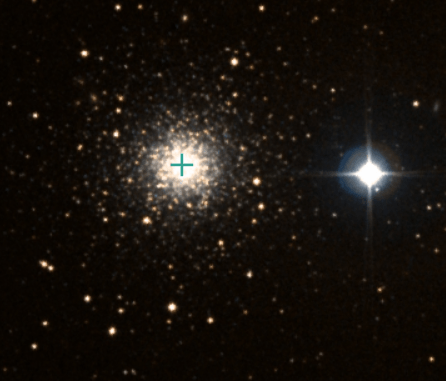DSO of the Month
Caldwell 25
AKA: Intergalactic Tramp; Intergalactic Wanderer; NGC 2419.
Position: 7 hr 38.1 min 38 deg 52 min 55 sec
Due south at 21:55 (GMT) on 15 February
Image of Caldwell 25 and HD 60771 from Simbad.
Let us begin with Caldwell 25’s odd name: the Intergalactic Wanderer or as I prefer to call it, the Intergalactic Tramp. It was first called the Intergalactic Tramp by the famous astronomer Harlow Shapley in a talk in 1932. He used the name to indicate that the cluster was very far from the galactic centre (it is about 300,000 light years away) and that it was, in a sense just passing by like a vagabond (another term he used in his talk). It is clear that the first person to use the alternative name “Intergalactic Wanderer” was Robert Burnham Jr in his Celestial Handbook, published by Dover in 1978. However it is less clear why he did this. Perhaps Burnham (who eventually became homeless himself) may have felt it was unfair to use the derogatory term “tramp”. Given that Shapley spoke in 1932 of the “strange wanderings” of the vagabond stars which were scarcely attached to our galaxy, this was an apt alternative.
While it might be considered hyperbolic to call it intergalactic, it is in fact further out than either of the Magellanic Clouds which are (dwarf) galaxies. However, it is definitely gravitationally bound to the Milky Way galaxy, although it takes 3 billion years to complete its orbit of the galaxy. It is thus one of the most distant individual objects we can see in a small telescope. Caldwell 25 is dim (magnitude 10.0) and small (apparent diameter 6 arc seconds, a bit larger than Uranus), but it can be seen in a small telescope and I have seen it in a five inch telescope. To find Caldwell 25, which is formally in the indistinct constellation of Lynx, you will probably need to use go-to, but it is roughly halfway on a line between Castor (Alpha Geminorum) and 21 Lyncis (which is only magnitude 4.6). However once you get to the right area, two relatively bright stars point towards it in a straight line, namely HD 60771 (mag. 7.2) which is 4 arc minutes away and HD 60694 (mag. 8.0) a bit further out. Given its great distance, it does not look much like a globular cluster (to resolve its stars fully one needs the Hubble Space Telescope), and it appears in a small telescope as a tiny blue disk. But think of the distance: it is over 13 times more distant than Messier 13 in Hercules! Because it is as far out as the Magellanic Clouds, it has been wondered if it could be the core of a former dwarf galaxy like the Omega Centauri globular cluster in the southern hemisphere, but this has now been disproved. (My thanks to Stephen O’Meara for a discussion of the origin of the name Intergalactic Tramp.)
ARCHIVE
